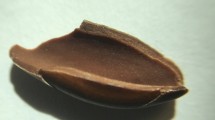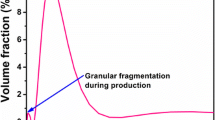Abstract
Overcoming limitations of poly (butylene succinate) (PBS) and enabling non-toxic, rapid production could lay the foundation for expanding applications in various fields. In this work, mechanically activated cassava starch (ACS) was used to augment the toughness of PBS and reduce the plasticization time of starch. The composite was prepared by melt blending PBS with two types of activated cassava starch particles (native starch and ACS) and acetyl tributyl citrate (ATBC) as a non-toxic plasticizer. X-ray diffractometer (XRD), Fourier transform infrared spectrometer (FTIR), scanning electronic microscope (SEM), and differential scanning calorimetry (DSC) were used to investigate the structural changes, compatibility, and dispersibility of ACS particles in PBS. The results showed that under high-speed shear and grinding, the hydrogen bonds within ACS molecules were severely disrupted and the amorphous regions increased, leading to improved compatibility with PBS. Under the plasticization of ATBC, the cross-section of ACS composites was smoother. DSC results showed that addition of ACS significantly reduced crystallinity of PBS/ACS composites. Mechanical properties results showed that impact strength and elongation at break of PBS/ACS-12A were, respectively, increased by 125% and over 5 times compared with that of PBS. Water absorption test and contact angle test demonstrate a significant improvement in the water resistance of PBS/ACS. This study provides a simple and feasible method for preparing low-cost PBS biocomposites, and their extensions are expected to further replace general-purpose plastics in daily application.








Similar content being viewed by others
References
Liu G-C, Zhang W-Q, Wang X-L, Wang Y-Z (2017) Synthesis and performances of poly (butylene-succinate) with enhanced viscosity and crystallization rate via introducing a small amount of diacetylene groups. Chin Chem Lett 28(2):354–357
Luyt AS, Malik SS (2019) Can biodegradable plastics solve plastic solid waste accumulation? Plastics to energy. Elsevier, Norwich, pp 403–423
Zhang S, He Y, Yin Y, Jiang G (2019) Fabrication of innovative thermoplastic starch bio-elastomer to achieve high toughness poly (butylene succinate) composites. Carbohydr Polym 206:827–836
Zhu C, Zhang Z, Liu Q, Wang Z, Jin J (2003) Synthesis and biodegradation of aliphatic polyesters from dicarboxylic acids and diols. J Appl Polym Sci 90(4):982–990
Jacquel N, Freyermouth F, Fenouillot F, Rousseau A, Pascault JP, Fuertes P, Saint-Loup R (2011) Synthesis and properties of poly (butylene succinate): efficiency of different transesterification catalysts. J Polym Sci Part A Polym Chem 49(24):5301–5312
Zakharova E, Lavilla C, Alla A, de Ilarduya AM, Muñoz-Guerra S (2014) Modification of properties of poly (butylene succinate) by copolymerization with tartaric acid-based monomers. Eur Polym J 61:263–273
Jin HJ, Kim DS, Kim MN, Lee IM, Lee HS, Yoon JS (2001) Synthesis and properties of poly (butylene succinate) with N-hexenyl side branches. J Appl Polym Sci 81(9):2219–2226
Shi K, Bai Z, Su T, Wang Z (2019) Selective enzymatic degradation and porous morphology of poly (butylene succinate)/poly (lactic acid) blends. Int J Biol Macromol 126:436–442
Jiang L, Zhang J (2017) Biodegradable and biobased polymers. Applied plastics engineering handbook. Elsevier, Norwich, pp 127–143
Abushammala H, Mao J (2020) Impact of the surface properties of cellulose nanocrystals on the crystallization kinetics of poly (butylene succinate). Crystals 10(3):196
Savitha K, Paghadar BR, Kumar MS, Jagadish R (2022) Polybutylene succinate, a potential bio-degradable polymer: synthesis, copolymerization and bio-degradation. Polym Chem 13(24):3562–3612
Aliotta L, Seggiani M, Lazzeri A, Gigante V, Cinelli P (2022) A brief review of poly (butylene succinate)(PBS) and its main copolymers: synthesis, blends, composites, biodegradability, and applications. Polymers 14(4):844
Freitas PA, González-Martínez C, Chiralt A (2023) Using rice straw fractions to develop reinforced, active PLA-starch bilayers for meat preservation. Food Chem 405:134990
Akay O, Altinkok C, Acik G, Yuce H, Ege GK (2021) A bio-based and non-toxic polyurethane film derived from luffa cylindrica cellulose and ʟ-Lysine diisocyanate ethyl ester. Eur Polym J 161:110856
Hararak B, Wanmolee W, Wijaranakul P, Prakymoramas N, Winotapun C, Kraithong W, Nakason K (2023) Physicochemical properties of lignin nanoparticles from softwood and their potential application in sustainable pre-harvest bagging as transparent UV-shielding films. Int J Biol Macromol 229:575–588
Park H, Oh J, Park Y, Kim S, Kim J (2022) Environmentally sustainable particulate filter fabricated via induced phase separation of bioderived fungal chitin and poly (lactic acid). Acs appl polym mater 5(1):452–462
Zeeman SC, Kossmann J, Smith AM (2010) Starch: its metabolism, evolution, and biotechnological modification in plants. Annu Rev Plant Biol 61:209–234
Sankri A, Arhaliass A, Dez I, Gaumont AC, Grohens Y, Lourdin D, Pillin I, Rolland-Sabaté A, Leroy E (2010) Thermoplastic starch plasticized by an ionic liquid. Carbohydr Polym 82(2):256–263
Qiao X, Tang Z, Sun K (2011) Plasticization of corn starch by polyol mixtures. Carbohydr Polym 83(2):659–664
Schmitt H, Guidez A, Prashantha K, Soulestin J, Lacrampe M, Krawczak P (2015) Studies on the effect of storage time and plasticizers on the structural variations in thermoplastic starch. Carbohydr Polym 115:364–372
Copeland L, Blazek J, Salman H, Tang MC (2009) Form and functionality of starch. Food Hydrocoll 23(6):1527–1534
Lourdin D, Putaux J-L, Potocki-Véronèse G, Chevigny C, Rolland-Sabaté A, and Buléon A (2015) Crystalline structure in starch. Starch: Metabolism and Structure: 61-90.
Vamadevan V, Bertoft E (2015) Structure-function relationships of starch components. Starch Stärke 67(1–2):55–68
Zeng J-B, Jiao L, Li Y-D, Srinivasan M, Li T, Wang Y-Z (2011) Bio-based blends of starch and poly (butylene succinate) with improved miscibility, mechanical properties, and reduced water absorption. Carbohydr Polym 83(2):762–768
Li J, Luo X, Lin X, Zhou Y (2013) Comparative study on the blends of PBS/thermoplastic starch prepared from waxy and normal corn starches. Starch Stärke 65(9–10):831–839
Wang W, Zhang G, Zhang W, Guo W, Wang J (2013) Processing and thermal behaviors of poly (butylene succinate) blends with highly-filled starch and glycerol. J Polym Environ 21:46–53
Abbott AP, Abolibda TZ, Davis SJ, Emmerling F, Lourdin D, Leroy E, Wise WR (2014) Glycol based plasticisers for salt modified starch. RSC Adv 4(76):40421–40427
Zhang Y, and Rempel C (2012) Retrogradation and antiplasticization of thermoplastic starch. Thermoplastic Elastomers. 118119
Mohammadi Nafchi A, Moradpour M, Saeidi M, Alias AK (2013) Thermoplastic starches: properties, challenges, and prospects. Starch Stärke 65(1–2):61–72
Alonso-González M, Felix M, Guerrero A, Romero A (2021) Rice bran-based bioplastics: effects of the mixing temperature on starch plastification and final properties. Int J Biol Macromol 188:932–940
Suchao-in K, Koombhongse P, Chirachanchai S (2014) Starch grafted poly (butylene succinate) via conjugating reaction and its role on enhancing the compatibility. Carbohydr Polym 102:95–102
Suttiruengwong S, Sotho K, Seadan M (2014) Effect of glycerol and reactive compatibilizers on poly (butylene succinate)/starch blends. J Renew Mater 2(1):85–92
Liu D, Qi Z, Zhang Y, Xu J, Guo B (2015) Poly (butylene succinate)(PBS)/ionic liquid plasticized starch blends: preparation, characterization, and properties. Starch Stärke 67(9–10):802–809
Xu J, Chen Y, Tian Y, Yang Z, Zhao Z, Du W, Zhang X (2021) Effect of ionic liquid 1-buyl-3-methylimidazolium halide on the structure and tensile property of PBS/corn starch blends. Int J Biol Macromol 172:170–177
Fang K, He W, Jiang Y, Li K, Li J (2020) Preparation, characterization and physicochemical properties of cassava starch-ferulic acid complexes by mechanical activation. Int J Biol Macromol 160:482–488
Acik G (2019) Soybean oil modified bio-based poly (vinyl alcohol) s via ring-opening polymerization. J Polym Environ 27(11):2618–2623
Wang M, Song X, Jiang J, Xia J, Ding H, Li M (2018) Plasticization and thermal behavior of hydroxyl and nitrogen rich group-containing tung-oil-based ester plasticizers for PVC. New J Chem 42(4):2422–2431
Halloran MW, Danielczak L, Nicell JA, Leask RL, Marić M (2022) Highly flexible polylactide food packaging plasticized with nontoxic, biosourced glycerol plasticizers. Acs Appl Polym Mater 4(5):3608–3617
Ouajai S, Shanks RA (2009) Biocomposites of cellulose acetate butyrate with modified hemp cellulose fibres. Macromol Mater Eng 294(3):213–221
Pang C, Shanks RA, Daver F (2015) Characterization of kenaf fiber composites prepared with tributyl citrate plasticized cellulose acetate. Compos Part A Appl S 70:52–58
Aliotta L, Canesi I, Lazzeri A (2021) Study on the preferential distribution of acetyl tributyl citrate in poly (lactic) acid-poly (butylene adipate-co-terephthalate) blends. Polym Test 98:107163
Umemura RT, Felisberti MI (2021) Plasticization of poly (3-hydroxybutyrate) with triethyl citrate: thermal and mechanical properties, morphology, and kinetics of crystallization. J Appl Polym Sci 138(10):49990
Zhang Z, Zhao S, Xiong S (2010) Morphology and physicochemical properties of mechanically activated rice starch. Carbohydr Polym 79(2):341–348
Zhang Y, Li W, Huang M, Xu X, Jiang M, Hu H, Huang Z, Liang J, Qin Y (2021) Non-digesting strategy for efficient bioconversion of cassava to bioethanol via mechanical activation and metal salts pretreatment. Renew Energy 169:95–103
Huang Z-Q, Lu J-P, Li X-H, Tong Z-F (2007) Effect of mechanical activation on physico-chemical properties and structure of cassava starch. Carbohydr Polym 68(1):128–135
Zdanowicz M, Jędrzejewski R, Pilawka R (2019) Deep eutectic solvents as simultaneous plasticizing and crosslinking agents for starch. Int J Biol Macromol 129:1040–1046
Bangar S P, Singh A, Ashogbon A O, and Bobade H (2023) Ball-milling: A sustainable and green approach for starch modification. Int J Biol Macromol 237
Lv Y, Zhang L, Li M, He X, Hao L, Dai Y (2019) Physicochemical properties and digestibility of potato starch treated by ball milling with tea polyphenols. Int J Biol Macromol 129:207–213
Su Y, Du H, Huo Y, Xu Y, Wang J, Wang L, Zhao S, Xiong S (2016) Characterization of cationic starch flocculants synthesized by dry process with ball milling activating method. Int J Biol Macromol 87:34–40
Yao S-F, Chen X-T, Ye H-M (2017) Investigation of structure and crystallization behavior of poly (butylene succinate) by fourier transform infrared spectroscopy. J Phys Chem B 121(40):9476–9485
Meng L, Yu L, Khalid S, Liu H, Zhang S, Duan Q, Chen L (2019) Preparation, microstructure and performance of poly (lactic acid)-Poly (butylene succinate-co-butyleneadipate)-starch hybrid composites. Compos Part B Eng 177:107384
Liu R, Sun W, Zhang Y, Huang Z, Hu H, Zhao M (2019) Preparation of starch dough using damaged cassava starch induced by mechanical activation to develop staple foods: application in crackers. Food Chem 271:284–290
He S, Qin Y, Walid E, Li L, Cui J, Ma Y (2014) Effect of ball-milling on the physicochemical properties of maize starch. Biotechnol rep 3:54–59
Iovino R, Zullo R, Rao M, Cassar L, Gianfreda L (2008) Biodegradation of poly (lactic acid)/starch/coir biocomposites under controlled composting conditions. Polym Degrad Stab 93(1):147–157
Then YY, Ibrahim NA, Zainuddin N, Ariffin H, Wan Yunus WMZ (2013) Oil palm mesocarp fiber as new lignocellulosic material for fabrication of polymer/fiber biocomposites. Int J Polym Sci 2013:797452
Acknowledgements
This work was financially supported by the National Key R&D Program of China (No. 2022YFB2602605), Natural Science Foundation of Changsha (No. kq2202184), and Hunan Provincial Science and Technology Department (No. 2021GK5007).
Author information
Authors and Affiliations
Corresponding author
Ethics declarations
Conflict of interest
The authors declare no competing financial interest.
Additional information
Publisher's Note
Springer Nature remains neutral with regard to jurisdictional claims in published maps and institutional affiliations.
Rights and permissions
Springer Nature or its licensor (e.g. a society or other partner) holds exclusive rights to this article under a publishing agreement with the author(s) or other rightsholder(s); author self-archiving of the accepted manuscript version of this article is solely governed by the terms of such publishing agreement and applicable law.
About this article
Cite this article
Li, Y., Li, Z., Sheng, S. et al. Preparation and properties of rapidly plasticized poly (butylene succinate)/mechanically activated cassava starch biocomposite. Polym. Bull. 81, 6495–6511 (2024). https://doi.org/10.1007/s00289-023-05018-7
Received:
Revised:
Accepted:
Published:
Issue Date:
DOI: https://doi.org/10.1007/s00289-023-05018-7




